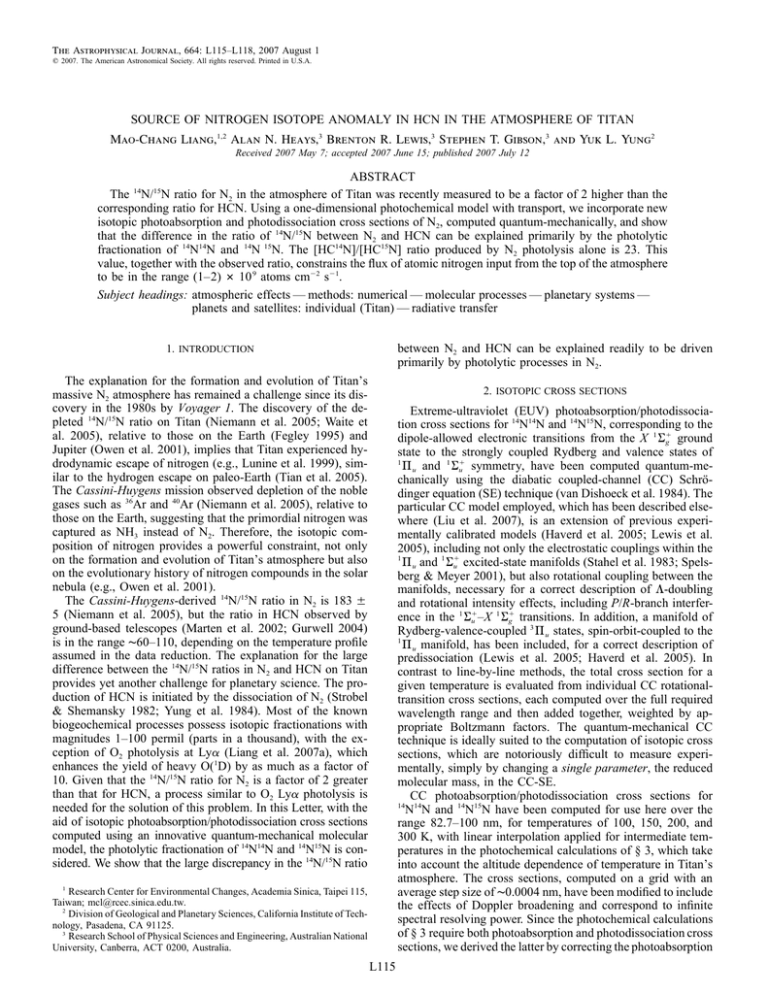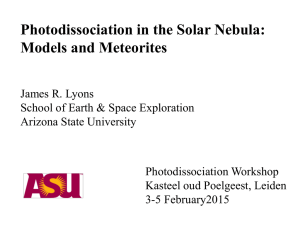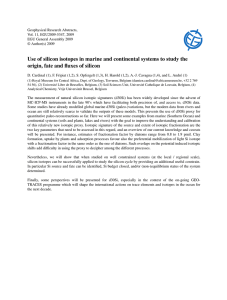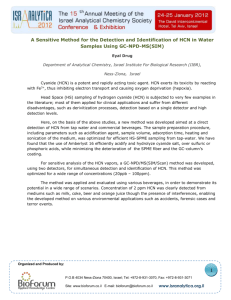
The Astrophysical Journal, 664: L115–L118, 2007 August 1
䉷 2007. The American Astronomical Society. All rights reserved. Printed in U.S.A.
SOURCE OF NITROGEN ISOTOPE ANOMALY IN HCN IN THE ATMOSPHERE OF TITAN
Mao-Chang Liang,1,2 Alan N. Heays,3 Brenton R. Lewis,3 Stephen T. Gibson,3 and Yuk L. Yung2
Received 2007 May 7; accepted 2007 June 15; published 2007 July 12
ABSTRACT
The 14N/15N ratio for N2 in the atmosphere of Titan was recently measured to be a factor of 2 higher than the
corresponding ratio for HCN. Using a one-dimensional photochemical model with transport, we incorporate new
isotopic photoabsorption and photodissociation cross sections of N2, computed quantum-mechanically, and show
that the difference in the ratio of 14N/15N between N2 and HCN can be explained primarily by the photolytic
fractionation of 14N14N and 14N 15N. The [HC14N]/[HC15N] ratio produced by N2 photolysis alone is 23. This
value, together with the observed ratio, constrains the flux of atomic nitrogen input from the top of the atmosphere
to be in the range (1–2) # 10 9 atoms cm⫺2 s⫺1.
Subject headings: atmospheric effects — methods: numerical — molecular processes — planetary systems —
planets and satellites: individual (Titan) — radiative transfer
between N2 and HCN can be explained readily to be driven
primarily by photolytic processes in N2.
1. INTRODUCTION
The explanation for the formation and evolution of Titan’s
massive N2 atmosphere has remained a challenge since its discovery in the 1980s by Voyager 1. The discovery of the depleted 14N/15N ratio on Titan (Niemann et al. 2005; Waite et
al. 2005), relative to those on the Earth (Fegley 1995) and
Jupiter (Owen et al. 2001), implies that Titan experienced hydrodynamic escape of nitrogen (e.g., Lunine et al. 1999), similar to the hydrogen escape on paleo-Earth (Tian et al. 2005).
The Cassini-Huygens mission observed depletion of the noble
gases such as 36Ar and 40Ar (Niemann et al. 2005), relative to
those on the Earth, suggesting that the primordial nitrogen was
captured as NH3 instead of N2. Therefore, the isotopic composition of nitrogen provides a powerful constraint, not only
on the formation and evolution of Titan’s atmosphere but also
on the evolutionary history of nitrogen compounds in the solar
nebula (e.g., Owen et al. 2001).
The Cassini-Huygens-derived 14N/15N ratio in N2 is 183 Ⳳ
5 (Niemann et al. 2005), but the ratio in HCN observed by
ground-based telescopes (Marten et al. 2002; Gurwell 2004)
is in the range ∼60–110, depending on the temperature profile
assumed in the data reduction. The explanation for the large
difference between the 14N/15N ratios in N2 and HCN on Titan
provides yet another challenge for planetary science. The production of HCN is initiated by the dissociation of N2 (Strobel
& Shemansky 1982; Yung et al. 1984). Most of the known
biogeochemical processes possess isotopic fractionations with
magnitudes 1–100 permil (parts in a thousand), with the exception of O2 photolysis at Lya (Liang et al. 2007a), which
enhances the yield of heavy O(1D) by as much as a factor of
10. Given that the 14N/15N ratio for N2 is a factor of 2 greater
than that for HCN, a process similar to O2 Lya photolysis is
needed for the solution of this problem. In this Letter, with the
aid of isotopic photoabsorption/photodissociation cross sections
computed using an innovative quantum-mechanical molecular
model, the photolytic fractionation of 14N14N and 14N15N is considered. We show that the large discrepancy in the 14N/15N ratio
2. ISOTOPIC CROSS SECTIONS
Extreme-ultraviolet (EUV) photoabsorption/photodissociation cross sections for 14N14N and 14N15N, corresponding to the
dipole-allowed electronic transitions from the X 1 Sg⫹ ground
state to the strongly coupled Rydberg and valence states of
1
P u and 1 S⫹u symmetry, have been computed quantum-mechanically using the diabatic coupled-channel (CC) Schrödinger equation (SE) technique (van Dishoeck et al. 1984). The
particular CC model employed, which has been described elsewhere (Liu et al. 2007), is an extension of previous experimentally calibrated models (Haverd et al. 2005; Lewis et al.
2005), including not only the electrostatic couplings within the
1
P u and 1 S⫹u excited-state manifolds (Stahel et al. 1983; Spelsberg & Meyer 2001), but also rotational coupling between the
manifolds, necessary for a correct description of L-doubling
and rotational intensity effects, including P/R-branch interference in the 1 S⫹u –X 1 S⫹g transitions. In addition, a manifold of
Rydberg-valence-coupled 3 P u states, spin-orbit-coupled to the
1
P u manifold, has been included, for a correct description of
predissociation (Lewis et al. 2005; Haverd et al. 2005). In
contrast to line-by-line methods, the total cross section for a
given temperature is evaluated from individual CC rotationaltransition cross sections, each computed over the full required
wavelength range and then added together, weighted by appropriate Boltzmann factors. The quantum-mechanical CC
technique is ideally suited to the computation of isotopic cross
sections, which are notoriously difficult to measure experimentally, simply by changing a single parameter, the reduced
molecular mass, in the CC-SE.
CC photoabsorption/photodissociation cross sections for
14 14
N N and 14N15N have been computed for use here over the
range 82.7–100 nm, for temperatures of 100, 150, 200, and
300 K, with linear interpolation applied for intermediate temperatures in the photochemical calculations of § 3, which take
into account the altitude dependence of temperature in Titan’s
atmosphere. The cross sections, computed on a grid with an
average step size of ∼0.0004 nm, have been modified to include
the effects of Doppler broadening and correspond to infinite
spectral resolving power. Since the photochemical calculations
of § 3 require both photoabsorption and photodissociation cross
sections, we derived the latter by correcting the photoabsorption
1
Research Center for Environmental Changes, Academia Sinica, Taipei 115,
Taiwan; mcl@rcec.sinica.edu.tw.
2
Division of Geological and Planetary Sciences, California Institute of Technology, Pasadena, CA 91125.
3
Research School of Physical Sciences and Engineering, Australian National
University, Canberra, ACT 0200, Australia.
L115
L116
LIANG ET AL.
cross sections using the CC-computed predissociation quantum
yields, determined on a rotational basis by comparison between
the relevant predissociation and radiative line widths. Since
almost all absorption by N2 results in dissociation in this region,
in practice corrections were necessary only for the b–X(1, 0)
and c –X(0, 0) bands, near 98.6 and 95.9 nm, respectively.
The CC photodissociation cross section for 14N14N at 150 K
is shown in Figure 1 (top). In this work, a boxcar average
smoothing algorithm with a width of 0.003 nm is applied to
the calculated cross sections. The smoothed ratio of the cross
sections for 14N15N and 14N14N is shown in Figure 1 (middle,
light curve), emphasizing the structural complexity. Also shown
in the figure (dark curve) is the same ratio with 0.1 nm smoothing, which greatly reduces the structural variation in the spectra,
suggesting that high-resolution spectra are required in order for
isotope-selective shielding effects to be represented properly.
Full-resolution calculations, discussed below, indicate that a
grid width of 0.003 nm is sufficient for the photochemical
modeling in § 3. We note that while the present isotopic cross
sections are expected to be very reliable at the longer wavelengths, and indeed are the only ones available, some higher
Rydberg states have been omitted from the CC model, leading
to greater uncertainties at the shorter wavelengths. However,
considering the weaker dissociation in this region, this limitation is not expected to be of significance to the present application of the CC cross sections. For wavelengths !82.7 nm,
the high-resolution (∼0.006 nm full width at half-maximum
[FWHM]) 14N14N photoabsorption and photodissociation cross
sections of Shaw et al. (1992) have been employed to supplement the CC cross sections, with zero-point-energy (ZPE) shifting (Yung & Miller 1997) applied to estimate the photolytic
fractionation associated with this wavelength region. This approximation is not important since photodissociation at wavelengths !82.7 nm contributes only 10% of the total.
3. PHOTOCHEMICAL MODELING AND RESULTS
The photolytic efficiency of an atmospheric molecule is related to the product of the incident solar flux and the molecular
photodissociation cross section. Shifts in the ground- and excited-state rovibrational energies due to isotopic substitution
cause corresponding shifts in the photoabsorption and photodissociation cross sections, which may result in significant differences in photolytic efficiency for the various isotopomers/
isotopologues. In order for such photolysis-induced isotopic
fractionation to occur, the incident flux must exhibit spectral
structure, either naturally, for photolysis at the top of the atmosphere, or through structured atmospheric absorption, e.g., by
molecular bands, in the case of photolysis at lower altitudes,
or both. The case of the O(1D) product in O2 Lya photolysis
(Liang et al. 2007a) provides a classic example of an extreme
isotopic fractionation caused by significant shifts in isotopic
photodissociation spectra. In the case of interest here, isotopeselective shielding allows more dissociative photons for 14N15N
to penetrate deeper into Titan’s atmosphere, resulting in higher
photolytic efficiency for 14N15N than for 14N14N and, therefore,
leading to a higher HC15N production rate.
Vertical profiles of species important for HCN formation
have been calculated using a one-dimensional photochemical
model (Yung et al. 1984; Liang et al. 2007c). Vertical eddy
mixing coefficients and nitrogen and hydrocarbon photochemical reactions are taken from the literature (Yung et al. 1984;
Liang et al. 2007c). The temperature profile, transport, and
physicochemical molecular processes are taken to be the same
Vol. 664
Fig. 1.—Top: Calculated CC photodissociation cross section (cm2) for 14N14N
at 150 K. Middle: Ratio of the smoothed photodissociation cross sections of
14 15
N N and 14N14N at 150 K (light curve, 0.003 nm smoothing; dark curve,
0.1 nm smoothing). Bottom: Observed (dark curve) and synthetic (light curve;
see text) solar spectrum (photons cm⫺2 s⫺1 Å⫺1), scaled at 1 AU.
as in Liang et al. (2007c). The chemical reactions adopted in
this work are a subset of those of Liang et al. (2007c): we
consider hydrocarbon chemistry up to C2 species and nitrogen
chemistry up to HCN (i.e., N2, N, CN, NH, and HCN). The
modeled HCN abundance with this simplified chemistry agrees
with that of Liang et al. (2007c) to within a factor of 2. The
results presented here will be unaffected by the selection of
either simplified or complete hydrocarbon and nitrogen chemistry, as long as chemical processes other than N2 photolysis
are isotopically neutral. The ratio of 14N/15N in N2 in the lower
atmosphere used in this work is 183 (Niemann et al. 2005).
The solar spectrum used for the N2 photoabsorption and photodissociation calculations, shown in Figure 1 (bottom, dark
curve), is taken from the literature (Woods et al. 1998; Ribas
et al. 2005), with a spectral resolution of 0.2 nm FWHM. We
then interpolate the solar spectrum onto the 0.003 nm grid used
for the photoabsorption and photodissociation cross sections of
N2.
The calculated photodissociation rates for 14N14N (solid curve)
and 14N15N (dashed curve), corresponding to the wavelength
range 80–100 nm, are shown in the left panel of Figure 2. The
total photoabsorption rate of N2 in the atmosphere of Titan is
1.9 # 10 8 molecules cm⫺2 s⫺1, with photofragmentation of N2
only accounting for ∼67%. Unlike normal N2, where the rate
peaks at 930 km, the isotope-selective photodissociation moves
the 14N15N maximum down to 820 km. The right panel of Figure
2 shows the profile of the ratio of the photodissociation coefficients (J-values, defined by the product of the attenuated
UV flux and the photodissociation cross section of the species)
for 14N15N and 14N14N, demonstrating a maximum at 760 km.
N2 photolysis is thus a mechanism capable of driving large
fractionations in the atmosphere of Titan. Subsequent chemical
and dynamical processes act to reduce the fractionation in N
and HCN (see below).
No. 2, 2007
14
N/15N ON TITAN
Fig. 2.—Left: Calculated photodissociation rates for 14N14N (solid curve)
and 14N15N (dashed curve) in Titan’s atmosphere. The additional absorption
by CH4 has been included in the calculations. These two species (N2 and CH4)
are the major absorbers at wavelengths between 80 and 100 nm. Right: Ratio
of the isotopic photodissociation coefficients.
The model-calculated ratios of the abundances of HC14N and
HC15N in Titan’s atmosphere are presented in Figure 3. A reference case that assumes no isotopic fractionation in the photolysis of N2 yields the isotopic ratio given by the dotted line.
The increasing nitrogen isotope ratio in HCN (also for other
species such as N2) above ∼750 km, where the homopause is
located, is caused by diffusive separation which depletes the
abundance of heavy relative to light species. It is interesting to
note that the ratio in the lower atmosphere is 223, a value greater
than that (183) for N2 in this region of the atmosphere. The
greater isotopic ratio for HCN than for N2 occurs because most
of the HCN production takes place above ∼800 km (Fig. 2),
where its precursor, N2, has a larger 14N/15N ratio.
The addition of 14N14N and 14N15N photolysis at wavelengths
180 nm (Fig. 1), in this case assumed to be the only source
of atomic nitrogen, yields the short-dashed curve in Figure 3,
corresponding to a ratio of 14N/15N p 23 for HCN at lower
altitudes. This large isotopic effect is caused primarily by the
shifts in the rovibrational transition energies of N2 due to isotopic substitution, together with associated differences in line
intensities, including changes in nuclear-spin-mediated rotational intensity alternation and, to a lesser extent, predissociation yields. Also shown in Figure 3 (long-dashed curve) is the
result of an approximate treatment in which the 14N15N cross
section is estimated by ZPE-shifting the present CC cross section for 14N14N. While the computed isotopic ratio in this case
is reasonably close to the full-model value of 23, there is no
reason to expect the ZPE-shifting technique to be valid in the
case of highly structured coupled-states absorption spectra,
such as for N2. The magnitude of the photolytic fractionation
suggests that other processes are required in order to reproduce
the observed ratio of 14N/15N in HCN of ∼60–100.
N2 dissociation by cosmic-ray and Saturnian magnetospheric
ion/electron impact provides an additional source of atomic
nitrogen in the upper atmosphere of Titan. This source has been
estimated to be 2 # 10 9 atoms cm⫺2 s⫺1 (Strobel & Shemansky
1982; Yung et al. 1984). If we assume that the 14N/15N ratio
of atomic nitrogen produced by ion/electron impact equals that
of N2 at the top of the atmosphere (i.e., 14N/15N p 260), the
predicted 14N/15N ratio in HCN is 127. If the source is unaffected by molecular diffusion processes (i.e., 14N/15N p 183),
L117
Fig. 3.—Modeled ratios of HC14N and HC15N, with (short-dashed curve)
and without (dotted curve) N2 photolytic fractionation. The solid and dashdotted curves represent modeled ratios for the cases of photolytic fractionation
and an additional atomic nitrogen flux of 2 # 109 and 1 # 109 atoms cm⫺2
s⫺1, respectively; the isotopic composition in this flux is assumed to be 183.
The shaded area represents the observed range of [HC14N]/[HC15N] (Gurwell
2004). For comparison, an approximate calculation based on ZPE-shifting the
14 14
N N spectrum (see text), which does not include nitrogen flux from the top
of the atmosphere, is shown as a long-dashed curve.
then [HC14N]/[HC15N] p 107. The actual value of 14N/15N in
the atomic nitrogen source lies between 183 and 260. The
strength of the source also affects the results presented here.
Assuming 14N/15N p 260 and a source strength of 1 # 10 9
(3 # 10 9) atoms cm⫺2 s⫺1, the predicted [HC14N]/[HC15N] p
86 (151). Model results for fluxes of 1 # 10 9 and 2 # 10 9
atoms cm⫺2 s⫺1, with 14N/15N p 183, are shown in Figure 3
as dash-dotted and solid curves, respectively. This study of the
sensitivity of the isotopic ratio to the strength of the N source
constrains the input N flux to be (1–2) # 10 9 atoms cm⫺2
s⫺1, consistent with that derived previously.
The results presented above are sensitive to structural variations in both the solar and N2 photodissociation spectra. In
order to test the effect of the limited-resolution solar spectrum
employed here, we have carried out a simulation using the fullresolution N2 cross sections obtained in this work, together
with a line-resolved synthetic solar spectrum (Fig. 1, bottom,
light curve). This high-resolution spectrum is based on a semiempirical model of the emission of the Sun in the EUV, with
spectral resolution on the order of 0.001 Å FWHM (D. E.
Shemansky et al. 2007, in preparation), which is same as that
used for transmission calculations in the atmosphere of Titan
(Shemansky et al. 2005; Liang et al. 2007c). The full-resolution
calculation reduces the calculated [HC14N]/[HC15N] ratio by
only 2%.
4. DISCUSSION
We have demonstrated that the large difference between the
nitrogen isotope ratios observed in N2 and HCN can readily
be explained by the photochemical processes of 14N14N and
14 15
N N, together with an additional source of atomic nitrogen,
produced by cosmic-ray and Saturnian magnetospheric ion/
electron-impact-induced N2 dissociation, in the upper atmosphere of Titan. The main process driving the fractionation is
isotope-selective shielding by N2 that enhances the photolysis
rate of 14N15N at lower altitudes. This process of modifying the
dissociation rate of less abundant isotopomers/isotopologues is
similar to those in the interstellar medium (ISM) (van Dishoeck
L118
LIANG ET AL.
& Black 1988) and solar nebula (Lyons & Young 2005). Furthermore, the mechanism of ion-neutral chemistry that is proposed to fractionate the nitrogen isotope abundances in the ISM
(Terzieva & Herbst 2000) can be ruled out as a primary source
of nitrogen fractionation between N2 and HCN in the atmosphere of Titan, for the following reasons. First, ion-neutral
chemistry as a source of HCN accounts for only 40% of total
production and is important only in the region above 1000 km
(Wilson & Atreya 2004), while the 14N15N photolysis occurs
mainly near 800 km. Second, the ion-neutral chemistry can
only produce a fractionation less than 30% (Terzieva & Herbst
2000), which is insufficient to explain the difference between
the observed 14N/15N ratios in N2 and HCN.
By analogy with the O ⫹ O2 isotopic-exchange reaction
occurring during the formation of O3 (e.g., Liang et al. 2006),
one may speculate on the possibility of a similar N ⫹ N2
reaction altering the strength of N-atom influx derived in this
Letter. Such an isotopic-exchange reaction between N and N2
could act to reduce the isotopic fractionation from N2 photolysis, a role similar to that of the N influx. In order for this
reaction to play a role, the rate coefficient has to be 110⫺17
cm3 s⫺1, a value that is very unlikely. The exchange of an N
atom between N and N2 is expected to be a slow process. Even
though the formation of an intermediate N3 radical is possible
(Zhang et al. 2005), the N-N triple bond is too strong to be
broken under the conditions prevailing in the upper atmosphere
of Titan. An upper limit for the rate coefficient of the N-exchange reaction may be estimated by considering the reaction
H2 ⫹ D r HD ⫹ H, for which the rate coefficient is 3.17 #
10⫺10 exp (⫺5205/T) cm3 s⫺1, where T (K) is the temperature
(Michael et al. 2004). Even at this upper limit, the exchange
Vol. 664
reaction is unimportant for N. A further possible mechanism
for the enrichment of HC15N is the photoinduced isotopic fractionation effect in HCN itself, which can be calculated, e.g.,
based on ZPE shifting (Yung & Miller 1997; Liang et al. 2004).
However, a preliminary estimate shows that the effect due to
HCN photolysis is very small compared with the effect demonstrated here to result from the photolysis of N2.
There remains a major challenge to explain the low 14N/15N
ratio for N2 in the atmosphere of Titan. In view of our success
in explaining the isotopic composition of HCN, we believe that
the resolution of the nitrogen isotopic fraction lies in (1) the
photochemistry of NH3 (Atreya et al. 1978), (2) the isotopic
fractionation of 15N in NH3 photolysis (Liang et al. 2007b), and
(3) hydrodynamic escape (Lunine et al. 1999; Tian et al. 2005).
It is conceivable that some of the nitrogen in the primitive
Titan might have been sequestered as HCN subduction to the
interior of Titan, followed by conversion back to N2, which
would contribute to the isotopic enrichment of 15N in the N2
atmosphere.
This research was supported by NASA grant NNG06GF33G
and Cassini grant JPL.1256000 to the California Institute of
Technology, and Australian Research Council Discovery Program grants DP0558962 and DP0773050 to the Australian National University. Special thanks are due to D. Shemansky for
providing a high-resolution solar spectrum. We also thank K.
Dere, F. Mills, I. Ribas, and T. Woods for helpful discussion
on the issue of the solar EUV flux, and N. Heavens and R. L.
Shia for reading the manuscript. We thank W. DeMore, C.
Miller, and H. Waite for valuable discussions on isotopic
fractionation.
REFERENCES
Atreya, S. K., Donahue, T. M., & Kuhn, W. R. 1978, Science, 201, 611
Fegley, B. 1995, in Global Earth Physics: A Handbook of Physical Constants,
ed. T. J. Ahrens (Washington: AGU), 320
Gurwell, M. A. 2004, ApJ, 616, L7
Haverd, V. E., Lewis, B. R., Gibson, S. T., & Stark, G. 2005, J. Chem. Phys.,
123, 214304
Lewis, B. R., Gibson, S. T., Zhang, W., Lefebvre-Brion, H., & Robbe, J.-M.
2005, J. Chem. Phys., 122, 144302
Liang, M. C., Blake, G. A., Lewis, B. R., & Yung, Y. L. 2007a, Proc. Natl.
Acad. Sci., 104, 21
Liang, M. C., Blake, G. A., & Yung, Y. L. 2004, J. Geophys. Res., 109,
D10308
Liang, M. C., Cheng, B. M., Lu, H. C., Chen, H. K., Alam, M. S., Lee, Y. P.,
& Yung, Y. L. 2007b, ApJ, 657, L117
Liang, M. C., Irion, F. W., Weibel, J. D., Miller, C. E., Blake, G. A., & Yung,
Y. L. 2006, J. Geophys. Res., 111, D02302
Liang, M. C., Yung, Y. L., & Shemansky, D. E. 2007c, ApJ, 661, L199
Liu, X., et al. 2007, ApJ, submitted
Lunine, J. I., Yung, Y. L., & Lorenz, R. D. 1999, Planet. Space Sci., 47, 1291
Lyons, J. R., & Young, E. D. 2005, Nature, 435, 317
Marten, A., Hidayat, T., Biraud, Y., & Moreno, R. 2002, Icarus, 158, 532
Michael, J. V., Su, M. C., & Sutherland, J. W. 2004, J. Phys. Chem. A, 108,
432
Niemann, H. B., et al. 2005, Nature, 438, 779
Owen, T., Mahaffy, P. R., Niemann, H. B., Atreya, S., & Wong, M. 2001,
ApJ, 553, L77
Ribas, I., Guinan, E. F., Gudel, M., & Audard, M. 2005, ApJ, 622, 680
Shaw, D. A., Holland, D. M. P., MacDonald, M. A., Hopkirk, A., Hayes, M.
A., & McSweeney, S. M. 1992, Chem. Phys., 166, 379
Shemansky, D. E., Stewart, A. I. F., West, R. A., Esposito, L. W., Hallett, J. T.,
& Liu, X. M. 2005, Science, 308, 978
Spelsberg, D., & Meyer, W. 2001, J. Chem. Phys., 115, 6438
Stahel, D., Leoni, M., & Dressler, K. 1983, J. Chem. Phys., 79, 2541
Strobel, D. F., & Shemansky, D. E. 1982, J. Geophys. Res., 87, 1361
Terzieva, R., & Herbst, E. 2000, MNRAS, 317, 563
Tian, F., Toon, O. B., Pavlov, A. A., & Sterck, H. D. 2005, Science, 308,
1014
van Dishoeck, E. F., & Black, J. H. 1988, ApJ, 334, 771
van Dishoeck, E. F., van Hemert, M. C., Allison, A. C., & Dalgarno, A. 1984,
J. Chem. Phys., 81, 5709
Waite, J. H., et al. 2005, Science, 308, 982
Wilson, E. H., & Atreya, S. K. 2004, J. Geophys. Res., 109, E06002
Woods, T. N., Rottman, G. J., Bailey, S. M., Solomon, S. C., & Worden, J. R.
1998, Sol. Phys., 177, 133
Yung, Y. L., Allen, M., & Pinto, J. P. 1984, ApJS, 55, 465
Yung, Y. L., & Miller, C. E. 1997, Science, 278, 1778
Zhang, P., Morokuma, K., & Wodtke, A. M. 2005, J. Chem. Phys., 122, 014106





